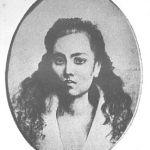A celebration of the 153rd Birthday of Dr. Jose Rizal – June 26, 2014
WELCOME – LYDIA S. DE LA CRUZ
Good Evening; Deputy Consul General Jaime Ramon Ascalon, Members of the Board, our sponsors and patrons of the arts and friends of the Museo.
A birthday celebration is a very personal thing. In planning for Dr. Jose Rizal’s 153rd birthday I wanted to know what kind of a man he truly was and the idea of doing an in depth of his love affair with Leonor Rivera became my choice. I wanted proof that Leonor is truly the love of Rizal so I consulted Dr. Penelope V. Flores, PhD. a professor in Education at the San Francisco State University and currently finishing her book about Dr. Jose Rizal’s travel with Viola. She accommodated me and provided me the material that I am looking for that was published at the La Solidaridad.
Much information is available about Dr. Jose Rizal and Leonor Rivera but for the benefit of some of our guests let me give you a brief biography of Leonor Rivera:
Leonor Rivera
- Rizal at 29
- Sketch of Leonor Rivera
Leonor Rivera was born in Camiling, Tarlac on April 11, 1867. Her parents are Antonio Rivera and Silvestra Bauzon. Her father, Antonio Rivera is a distant cousin of Rizal’s father, which is one of the reasons they kept their relationship a secret. She attended school at La Concordia College and was described as a talented, mature intelligent lady. She played harp and piano and had a charming voice. She could write and read Spanish. She was immortalized by Dr. Jose Rizal as the character Maria Clara in his novel- “Noli Me Tangere”. She was married to Henry Charles Kipping but died on August 28, 1893 from complications of child birth, shortly after the birth of her second son.
What is La Solidaridad?
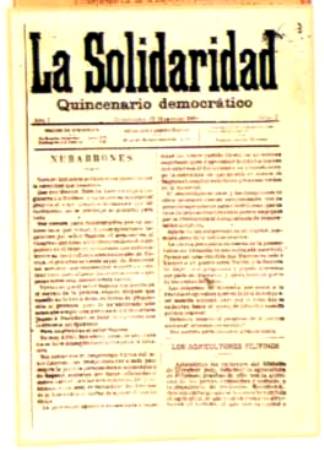
What is LA SOLIDARIDAD?
La Solidaridad (The Solidarity) was an organization created in Spain on December 13, 1888. Composed of Filipino liberals exiled in 1872 and students attending Europe’s universities, the organization aimed to increase Spanish awareness of the needs of its colony, the Philippines, and to propagate a closer relationship between the colony and Spain.
Headed by Jose Rizal’s cousin, Galiciano Apacible, it also issued a newspaper of the same name which was published in Barcelona Spain on February 15, 1889. The newspaper published not only articles and essays about the economic, cultural, political, and social conditions of the country, but also current news, both local and foreign, and speeches of prominent Spanish leaders about the Philippines.

Synopsis: A Kiss from Loleng
WELCOME – Lydia S. de la Cruz
For this evening’s reading we adopted the characters from the article “A Kiss from the Philippines,” published on July 15, 1890 in the “La Solidaridad” by pen name, “Taga-ilog”and broke them to the three main characters: Jose Rizal or Pepe, his friend Silverio and his love Leonor Rivera or Loleng. The dialogue is as written but to give more emphasis for the love and relationship of Jose Rizal and Leonor we aptly called the reading “A kiss from Loleng.” The setting is about the evening before Rizal’s departure to his travel to Europe; how he persistently demanded a kiss from Loleng as a gesture of her love for him. Loleng in turn was also firmed and deniably decline his request. We shall find out that Rizal’s behavior was just like any normal man in love, persistent but respectful; how Rizal accepts his disappointment to his simple request? How their loves endure the separations?
I would like to introduce our talented readers this evening:
- Dody Garcia – Dr. Jose Rizal
- Leon Palad – Silverio, a very close friend of Rizal
- Yours truly as Loleng
- Narrator – Dan de la Cruz
- Technical support – Rose Santos
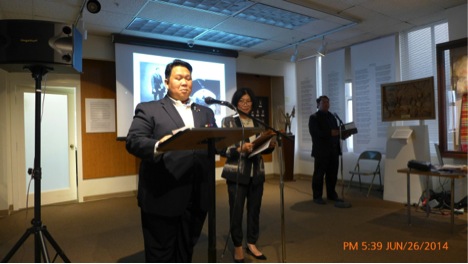
Cast from left to right: Dody Garcia as Rizal, Lydia de la Cruz as Loleng, Leon Palad as Silverio
Two of the letters from Leonor that have survived gives us a sense of what she was like and how the lovers tried to keep their relationship secret.


Since Leonor’s mother disapproved of their relationship, she used a code Rizal gave to her, which was Taimis
Letters between Rizal and Leonor
Two of the letters from Leonor that have survived give us a sense of what she was like and how the lovers tried to keep their relationship secret.
On January 2, 1881, Leonor wrote Rizal:
“Esteemed Friend,
“I received your letter dated 30 of last month and I am informed of its contents.
“If I have not received your letters, it was not because I’bored corresponding with you. In fact, twice I wrote replies, but on the day I did so, nobody came to visit me at the college ( La Concordia), so I destroyed them, and besides I was already embarrassed.
“I am doubtful if the letter is yours, it was not because the signature is different. Perhaps you have put another name, fearing that I might despise it and if I despise it, it will not be your name that will be despised but somebody else’s. If that is what you think, you are mistaken for you do not know how glad I am when I receive one of your dear letters: but you did well in putting another name in case, as you say, it may fall into the hands of strangers.“Command your servant who kisses your hand.
The second letter was written so many months later, on December 28, 1881, saying:
“Esteemed Jose“I would be glad if on the receipt of this you are in good health and happy.
“I was very much surprised that you had a letter for Papa and none for me; but at first when they told me about it I did not believe it, because he did not expect that a person like you would do such a thing. But later I was convinced that you are like a newly opened rose, very flushed and fragrant at the beginning, but afterwards it begins to wither. Before, however, when I did not write you, you wrote me, but now no more. It seems that you have imitated my example when I went to Antipolo and you have done wrong, because I was not in my own house, and besides you know very well that you cannot hide any thing from those girls. I could very well write to Papa, but in order that you might not say anything, I did not, though Mama had ordered me to do so. You cannot have these pretexts because you are at your home and nobody meddles with you. Truly I tell you that I’am very resentful for what you have done and for another thing that I’ll tell you later when you come.
“Excuse the writing and all the mistakes you find in it.
“Command at your pleasure your true servant who kisses your hand.
Example letters
Their exchange of letters lasted for 6 years. The two were known as “lovers by correspondence” because of their countless love letters written in different languages such as Filipino, English, Spanish and French. Shift in the languages used by Rizal was to prevent interception of the letters by the Spanish authorities.
The last letter Leonor ever received from Jose was written on March 30, 1884. He was 23 years old.
“Today I visited your family (relatives in Madrid), I do not know whether it is my patriotism or what but this family is very dear to me. The children are charming. One of the children, Josѐ, talked until I had a good laugh. The oldest girl has been in Concordia College and knows many girls there.
Then he writes in French
The girls of my own country please me greatly, but I have found one back home who has charmed and who makes me dream. Whenever I am overcome with pensive melancholy I unfold all my past before my vision. I am going to be like that traveler who goes down the road smelling flowers; he passes without touching them for fear they may prove unreal… My days pass swiftly and I see that I am becoming old for my age, as many people tell me. I do not have the smiling face of those with tranquil hearts and hopes for the future; yet I have done nothing that would not meet with your approval. My conscience does not trouble me, for I have deprived myself of many pleasures. I believe my heart has not lost any of its power to love…only the one I love most is not here.”

Jose Rizal in Barcelona, Spain
Because Leonor’s mother blocked all the letters of the lovers, Rizal only got information from his friends.
His friends use codes as well:
Mariano Katigbak, wrote in June, 1884, how down Leonor was:
“You would not know Leonor if you now saw her. Your sweetheart is going down very much, no doubt because of her worry. She, who, I think, knew love for the first and only time, has sacrificed the man of her heart, and sees that instead of the approach of a happy ending, that ending is getting farther away with gigantic strides.”
Jose M. Cecilio or “Chengoy” wrote him constantly about Leonor’s situation in the Philippines. He wrote:
September, 1885.
“I congratulate you on your good choice of the woman who is to be your faithful companion. She is no longer in Concordia College but in Dagupan, Pangasinan, besides her parents… and I do not know whether she will return to finish her education.”
He wrote again about his friend Sixto’s visit and observation of Leonor who was addressed as the Question of the Orient:
May, 1886.“The beautiful but delicate Question of the Orient is still in Dagupan beside her parents who rave about her. Her friend Sixto Lopez told me that he had been in that town, taking supper in their home…This young man became most enthusiastic over the Question, whom he found each day more precious and thrifty, but according to him she is now no more to be seen with as much finery as when we were together in their house.”
Forbidden Love
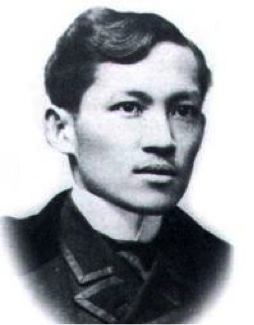
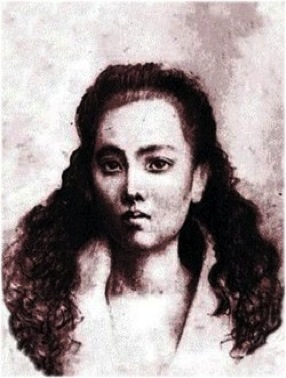
When Rizal decided to go back to Manila on August 3, 1887 the couple wanted to see each other but both were prohibited by their respective parents. Don Francisco Mercado believed that the meeting would put the Rivera family in danger for he was already labeled by the Spaniards as a “filibustero” or subversive because of the contents of his novel “Noli Me Tangere”.
Before his second departure from the country Rizal wanted to marry the uncomplaining Leonor and leave her in his sister Narcisa’s care. Don Francisco however consistently disapproved of Jose’s plan. His brother Paciano also thought that it was selfish of his brother to marry Leonor only to leave her behind. The meeting never happened.
In foreign lands, Rizal kept on sending letters to Leonor but received no reply. The lovers had no idea that Leonor’s mother, Doña Silvestra, who understandably did not like the controversial Filipino for a son-in-law had been hiding from Leonor all the letters and gifts sent to her by Rizal.
The mother convinced Leonor to marry Charles Henry Kipping, an English railway engineer who was responsible for the completion of the railroad from Manila-Dagupan. Doña Silvestra were said to have connived in making Leonor believe that Jose had already fallen in love with Dr. Ferdinand Blumentritt’s daughter.
When the wedding was fixed, Leonor received a letter from Rizal while her mother was in a business trip to Manila. She learned what her mother did which the latter admitted. Leonor Rivera was married to Kipping on June 17, 1891, two days before Rizal’s birthday. She asked for the letters from her mother. After reading all the letters her mother told her that it was not good for her to keep the letters because she had a husband so Leonor was only allowed to burn the letters and keep the ashes. She put it inside a box covered with a dress she had worn when she was thirteen years old with the letters “J” and “L” embroidered on it.
Six months before the ceremony, Rizal received a letter announcing the imminent Kipping-Rivera wedding. The letter was from his true love who was also asking for his forgiveness. The letter signaled the death of Rizal’s 11-year love affair with Leonor.
Epilogue
After two years of her married life, Leonor died on August 28, 1893 from complications of childbirth, while Jose was serving his term as an exile in Dapitan.
While walking towards the place of his execution on December 30, 1896, Rizal turned towards the sea and was said to have uttered”What a beautiful morning! On mornings like this, I used to take a walk with my sweetheart.” (Rizal’s Life, Works and Writings Ambeth Ocampo p,228)
The box with burned ashes of Rizal’s letter to Leonor was donated to Yuchengco Museum located at RCBC, Makati City by the descendants of the Kipping family for display during the month-long Rizal exhibit, Rizalizing the Future.
The End of the Romance.
Now I would like to introduce to you our classic guitarist Michael Gonzalez, who will share with us his classic rendition of “Kundiman ng Lahi”, also known as Joselinang Baliwag and “ Tango ni Rizal”. Both songs were popular during Rizal time.
Michael Gonzalez , Ed.D. was a professor at the University of the Philippines and currently a member of the faculty of the City College of San Francisco.
End of Program.


